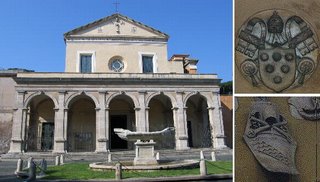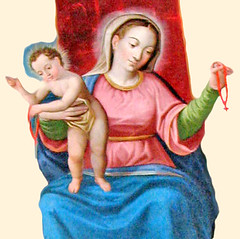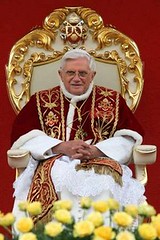Our Enlightenment in Christ
 Station at Saint Mary's in Dominica
Station at Saint Mary's in DominicaThe name of today's Stational church comes from the word 'dominicum', one of the ways Christian churches were named in Rome because they are the 'house of the Lord' or because Christians gathered there on the 'dies Domini', Lord's day. This basilica was built in the 9th century by Pope Paschal I on the site of an older Christian house which is believed to date to the 3rd or 4th century and was made a Roman parish in the 5th century. A mosaic in the apse of the church depicts Pope Paschal I kneeling before Our Lady enthroned with the Infant Jesus.
This ancient basilica actually stands on the Roman ruins of the barracks used by the 5th Cohort of Guards. Since its inception in the church has been used as an institution for helping the poor and St Lawrence is known to have distributed alms from here. A fountain called the 'Navicella' stands in front of the church and it is a 16th-century copy of an ancient ex voto offering from sailors to the pagan goddess Isis, superceded by Mary, the Star of the Sea. As such, the church is also called 'Santa Maria della Navicella'
Today's Gospel recounts the Lord's Transfiguration (Mk 9:2-10) which Pope John Paul II called the "mystery of light par excellence". As such, today's reflection by Fr Conrad Pepler, OP, looks at the mystery of Christ's Light which is evident in the dazzling brightness of the Transfiguration and he recalls the goal of Lent, which is that ultimately we too become transfigured into the likeness of Christ, to whom we are called to listen. Fr Conrad Pepler writes:
"The whole of Lent is ordered to an enlightenment in which the mind will share the Word of God and the will cease to be itself and become the will of God. 'O kindling burning love, how tenderly dost thou make me glorious by thy loving movements in my greatest power and strength, giving me divine intelligence according to the capacity of my understanding, and communicating love according to the utmost freedom of my will' (St John of the Cross, 'Living Flame').God the Son is the creative Light, the creative Word whence all things sprang, which was thus in the world from all time. But this Light came into the world in a new manner at the moment of the Incarnation, when the Word, the Light of the eternal Father, became flesh. For men had preferred to live in darkness, turning their minds and their wills from the supernatural light, 'men loved darkness rather than light, for their works were evil.' They were unenlightened, floundering amid the multitude of shadows in the cave. But the Light forced himself on their notice. He came near to them, so near as to share in their human nature, and they, for their part, shared in His light and reflected His own glorious nature. The Gospels, especially the Gospel of St John, are full of the idea of the dark world into which this great beam of light suddenly flashed. It penetrates into the very substance of men's souls, and as men are drawn within its ray so they are caught up into a new life given them by the new Sun, the source of all grace...
This light, then, comes from the one Source of all lights and settles in our souls. 'Then shall thy light rise up in darkness', says Isaiah, 'and thy darkness shall be as the noonday.' The natural source of all light gives being to all things, but this Light shares its very life with those object on whom it shines. As the ray share the nature of the sun, so this Light in our souls is the divine life whereby we are made sharers in the Trinity itself.
The process of enlightenment begins as soon as the divine life takes possession of our souls by grace; and this is accomplished by the grace of baptism. In the early Church [catechumens who had been handed the Creed were known as] 'those to be enlightened'; and when at last they had been baptized they were called the 'illuminati', the illuminated or enlightened ones. It is baptism that introduces the soul into the kingdom of light; as the waters pour over the head in the sign of the holy Cross, the divine Light pours into the soul and conforms it to Christ crucified. Mind and will are infused with grace so that the enlightened thinks the Thought of God (the Son) and loves the Love of God (the Holy Spirit)...
This culmination of Lent [baptism] is the foretaste of the ultimate culmination of the eternal Light of the beatific vision, for grace is the 'semen gloriae', the seed of the divine glory that envelops the soul in heaven. The 'rest' spoken of by Isaiah begins with the first infusion of grace; it is completed and perfected by the eternal rest when the Light shines in all its brightness. 'In thy light do we see light', sings the psalmist; and the Church unceasingly prays for her illumined children who have died that perpetual light may shine upon them...
But before this final completion of Easter glory is accomplished, the 'enlightened' Christian must conform himself in every way to his Model; and since his Model is the Light of the world, he must himself become a light of the world. The flame that has been enkindled in his soul must cast its light around him and seek to enkindle others with the flame of Christ... The spontaneous effect of this infusion of light into the soul is a desire to communicate it also to others; that this new light may help to penetrate more fully the surrounding darkness and bring more people into the kingdom where all are bound together in the embrace of the one divine ray."
The image of the Transfiguration above is from the beautiful chapel of Caleruega in the Philippines.







0 Comments:
Post a Comment
<< Home